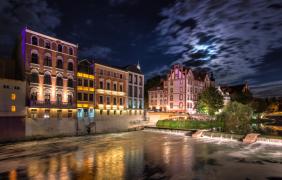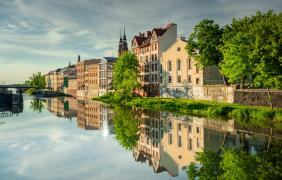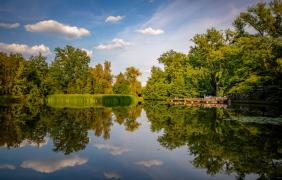
Romantic
Opole is a city to fall in love with. Summer is a particularly good time for a romantic walk. Time flies if you are in love, and the nature in Opole is the perfect background for confessions. The trail begins in the city centre and leads to the green Bolko Island, ending with the Hilltop Church at sunset..
Opole Venice
The Opole Venice and the local boulevards are a great place for a date or walk. The quiet murmur of the river straddled by several beautiful bridges, wonderful tenements reflecting in the water surface, illuminated so beautifully at night as to be hypnotising. All this surrounded by lush greenery decorating the beautiful avenues. The numerous scattered benches invite you to sit down and relax. The Opole Venice stretches along the beautiful Młynówka Canal, which separates the very centre of the city from Pasieka Island – a quiet residential district and one of the most charming and romantic places in Opole.
It is as beautiful during the day as it is at night-time, when the city slowly quiets down and Młynówka and its surrounding tenements light up in a myriad of colours. It certainly is one of the most beautiful spots in the Song Capital of Poland on a warm summer night!
The bridges connecting the banks are also worth mentioning. One of them is the 19th-century Castle Bridge, commonly known as the Yellow Bridge, which leads from the Piast Tower and the Voivodeship Office towards the Franciscan Church and the Market Square. Others include the Grosz Bridge, known among the locals as the Green Bridge, as well as the Cathedral Bridge, located near the largest church in the city, and the reinforced concrete bridge on Korfantego Street. It is then no wonder that this part of Opole is often compared to Venice in Italy, all the more so since the nearby City Hall is inspired by the Venetian Palazzo Vecchio.
Grosz Bridge
It is also known as the little green bridge, the bridge of sighs or the lovers’ bridge due the hundreds of padlocks with names and initials of couples hanging from the metal bars. Does that guarantee everlasting love? That is a secret we are not privy to. The bridge is beyond all doubt one of the most widely recognisable points of interest in the Polish Song Capital. The secession-style two-span metal pedestrian bridge hangs above the wonderfully green Młynówka Canal, connecting Pasieka and its villas with the centre of the city.
The bridge is also referred to as “Grosz Bridge” after the one-grosz toll that used to be collected there in the past. To be precise, back when Opole was part of Germany, the price for passage was one pfennig.
Bolko Island
Lush greenery concealing a tangle of paths and avenues – perfect for a long walk or bike ride. Benches and clearings to sit in... A lovely pond hidden among the bushes and many picturesque spots to simply marvel at natural beauty... Add to that chirping birds and murmuring water. Opole’s Bolko Island is a popular spot among the locals, and it certainly deserves to be called the green lungs of the city. It is a perfect place for a lazy outing or a long romantic walk with a partner. After your walk, you can enjoy a dinner for two at Laba, a restaurant surrounded by trees in the very heart of Bolko Island. It also has a pier, which is another romantic touch, as it is a perfect place to confess your feelings.
Steps at the Hilltop Church
A beautiful vista of the Opole Old Town stretches from these steps, making it a perfectly romantic sunset spot. The stairs lead to the oldest Roman Catholic church in Opole – the Church of Our Lady of Sorrows and St. Adalbert. At the back of the neighbouring Opole University is the Well of St. Adalbert, which has a legend tied to it. It is said that the well was dug out at a place where St. Adalbert gave his sermons sometime between 984 and 995. So fervently did he try to convert the local pagans that his feet left marks in the stone on which he was standing. When the priest ran out of water for baptising, he struck the stone with his rod, causing water to come out of it.
Perhaps your love culminates in Mendelssohn’s March – we hope it does!




